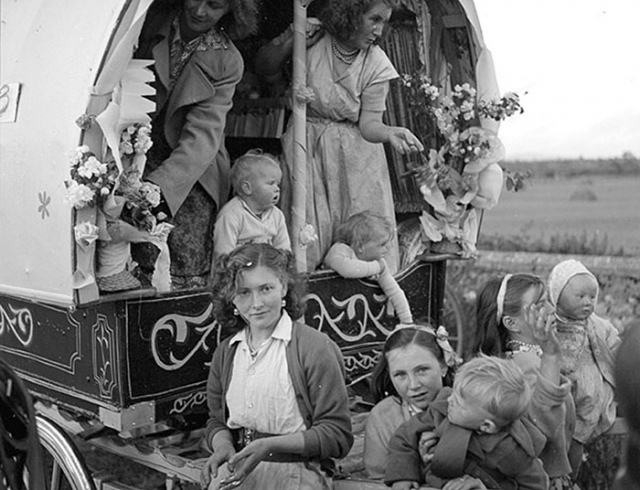Teaching Gypsy, Roma and Traveller history

In the UK
Gypsy, Roma and Traveller people are the largest minority ethnic group in some communities (and therefore in some schools) in the UK. Yet the past of Gypsy, Roma, Traveller people may rarely be part of history lessons. The result is that pupils of Gypsy, Roma and Traveller heritage may not encounter their past in history classrooms and myths and stereotypes may take root in the minds of others.

History teachers may not teach these histories because they lack knowledge about the Gypsy, Roma and Traveller past; they may lack cultural understanding and therefore be reticent to teach what could be sensitive and emotional material; and they may be very short of curriculum time. This webpage is designed to support teachers in this position to teach Gypsy, Roma and Traveller history.
Important context
The Council of Europe Strategic Action Plan for Roma and Traveller Inclusion (2020-2025) found that: “Many of the 10-12 million Roma and Travellers in Europe suffer from extreme poverty and exclusion. The existence of widespread anti-Gypsyism reinforces and aggravates their economic and social deprivation. These inequalities persist despite ongoing efforts at national, European, and international level to tackle anti-Roma and anti-Traveller prejudice, discrimination and crimes and address further their inclusion.” (p.7) and proposed the “Promotion of the teaching of Roma and Traveller history and the Roma Holocaust and inclusion in school curricula and textbooks, also through training of trainers and teachers” (p.20) as part of the solution.
On 1 July 2020 the Council of Europe (of which the UK is a member) set out seven ‘Principles and proposed actions for including the history of Roma and/or Travellers in school curricula and teaching materials’. The first of these states:
Teaching of the history of Roma and/or Travellers and its inclusion in national school curricula and teaching materials should:
- include a balanced and contextualised teaching of Roma and/or Travellers’ history, reflecting both their national presence and historical context and their common history as a people present in Europe for centuries;
- include information about the contribution of Roma and Travellers to the national economies, in particular trade, metalwork and other handicrafts, as well as animal husbandry, and refer to various aspects of Roma and/or Travellers’ history and culture, such as storytelling, literature, religion, music and traditions, as well as the asymmetric social progress and unequal access to social rights they have experienced.
Teacher subject knowledge
- Prof Becky Taylor, University of East Anglia, has recorded this podcast about the history of Gypsy, Roma and Traveller people in Britain (see also part 2). In it she also addresses matters of cultural understanding. Also recommended is Prof Taylor’s general European survey: Another Darkness, Another Dawn: a history of Gypsies, Roma and Travellers published by Reaktion Books in 2014
- A Short Animated History of Britain's Gypsies, Roma and Travellers called Roads from the Past from Travellers’ Times. It gives a short overview and is useful for teachers and pupils.
- Ensuring Gypsy, Roma and Traveller children do not feel unseen in the history classroom - Teaching History article by Richard Kerridge and Helen Snelson
- Our Migration Story: Romani Gypsies in 16th century Britain from Runnymede Trust
- Gypsies: an English History by David Cressey (OUP: 2018) is an excellent place to start for an overview of what is known about Gypsy, Roma and Traveller people and communities in England from Tudor to modern times.
- Eve Rosenhaft podcast: Romani History
- A text for gaining general awareness about contemporary communities is: 'Gypsies, Roma and Travellers, A Contemporary Analysis' by Declan Henry (Critical Publishing: 2022)
Teaching resources
- Secondary: Do Gypsy, Roma and Traveller children see themselves in your history classroom? - Helen Snelson and Richard Kerridge, 2022
- Primary: Promoting Gypsy, Roma and Traveller heritage in your primary history curriculum - Matthew Flynn (Primary History 89)
- Celebrating Gypsies, Roma and Travellers (PowerPoint slides, 4MB) - A display resource for Gypsy, Roma and Traveller History month in June – or for any other month of the year.
- No Place to Be: A Graphic History of Gypsies and Travellers in Modern Britain (PDF, 29MB) - Gerardo D’Ambrosio & Becky Taylor
- Life before the Romani Genocide - images and descriptions about life for Romani people in the 1920s and 30s.
- The Friends, Families and Travellers website has a teaching resources section, and their Gypsy, Roma & Traveller History Month page has an education pack as well as previous years' materials.
Other useful web-links for history teachers
- Council of Europe: Roma and Travellers - Culture and Education
- Council of Europe: Roma history factsheets
- Crystal’s Vardo Teaching Materials and Information
- Gypsy Roma Traveller History month resources
- Historic England: Searching for Romani Gypsy Heritage with John Henry Phillips (YouTube)
- Gypsy Traveller History in Scotland
- Heritage from Travellers’ Times, including photo stories and oral histories
- Holocaust Memorial Day Trust: Roma and Sinti People
- Mapping the Histories of London's Travellers
- Oral History: English and Irish Gypsy Traveller Communities
- Robert Dawson Gallery - a vast array of images
- Romany Genes - a web portal for a lot of Romany history online
- Roma Stories Oral History Project
- Romani Herstory: a digital archive
- Romany and Traveller Family History Society
- The Traveller Trust ‘Good Practice guide for improving GRT children’s educational outcomes’ (April 2019)
- Travellers’ Times Oral History films
- Gypsy Roma Traveller History Education Pack
- BESTROM Project - explores the cultural contribution to Europe’s public space/s of its Romani minorities (Roma, Sinti, Manouche, Gitanos, and others).
- CoE webinar report: the case of Roma history - with links
Attached files:
- Celebrating Gypsies, Roma and Travellers - a display resource
4.24 MB Powerpoint presentation - No Place to Be: A Graphic History of Gypsies and Travellers in Modern Britain - Gerardo D’Ambrosio & Becky Taylor
29.05 MB PDF document

